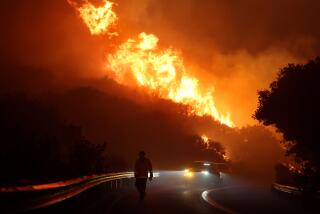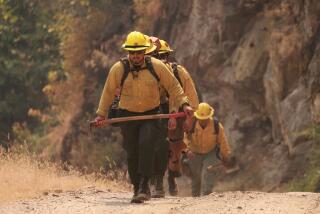Could a Freeze Gun Put Flames on Ice?
The old ways of fighting fire with fire, water and foam may work, but some inventors say they have better ideas: a freezing blast capable of encasing a two-story home in ice, for example, and a blimp that emulates a rainstorm.
Inventors, emboldened by fires that have consumed 5.7 million acres nationwide this year, are pitching their ideas to government agencies and homeowners. But most of the next-generation gadgetry has not caught on with the federal research center in San Dimas that assesses new ideas.
Undeterred by official rejection, though, the innovators go on freezing and flooding stuff to make their case.
Tim Beck’s Cryocrete freeze gun--a converted fire extinguisher--seems like a weapon no super villain should be without. Through a hose, the device blasts a mixture of rice-sized dry and regular ice pellets that freezes whatever it hits.
“It can stop a fire cold,” said Beck, a Torrance resident, who once ran a kidney bank that used subzero liquids to preserve organs.
Once frozen to a wall or roof, the sheet of ice draws more moisture from the air, just as a cold martini glass does. And as it warms over about two days, Beck said, the ice evaporates, leaving no water damage and no sticky foam to clean up.
Or at least that is the theory for the device, which has been tested only on a small, staged fire eight years ago. In 1994, an oil company gave Beck $500,000 to make prototypes of the freeze gun to fight fires and a similar one crafted from a leaf blower that was designed to freeze oil spills in the ocean.
He extinguished a small fire in a steel container during a demonstration for the Manhattan Beach Fire Department, which passed on the idea and is sticking with fire and foam.
Beck once envisioned firefighters spraying his Cryocrete to extinguish raging blazes, but realized that might be a bit too ambitious for the prototype.
Now he is pitching the ice gun as a fire prevention tool to homeowners associations in the crackling dry canyons of the Santa Monica Mountains. With no freeze gun on the market, residents would pay Beck to ice their homes when a fire breaks out nearby. Or at least that’s his hope.
The U.S. Forest Service’s San Dimas Technology and Development Center has heard it all before, and says inventors like Beck usually make the mistake of trying to revolutionize firefighting. The center, one of two in the country, studies about 100 new ideas each year and manages a $1.4-million budget to test and develop about 10 of them annually.
Beck asked the agency in June to consider using his technique to fight a wildfire. In language better left in an advanced physics lab, the technology center said the idea would not work on a large scale.
To make the concept work, the government would have to buy tons of dry ice and retrofit its equipment--rather than simply sucking up free water from a lake with firefighting helicopters.
This fire season more extravagant ideas than usual have rolled into the technology center, including various takes on freezing and a number of blimp designs.
Wetzone Engineering of Irvine is offering its twist on the oldest firefighting tool: rain. Wetzone has plans for a blimp the length of three football fields, or 4 1/2 times the length of the Goodyear blimp.
One of the ships could hover above a fire, the company says, dropping 20,000 gallons of water without having to refill. By comparison, the giant Super Scooper planes can dump 1,600 gallons at a time. The craft would be filled with water from a pump or by fire planes dumping their loads into a catch basin on top of the blimp. The blimp would then release a steady rain.
“This doesn’t hurt the environment at all, because it’s the way nature put out fires,” said Thomas Gagliano, a spokesman for the fledgling company.
Hope for a new market in firefighting has brought on a space race of sorts among airship manufacturers. About half a dozen firms are trying to market modified blimps that could be used for water drops or as mobile command posts for fire captains.
Bruce Blake, owner of Portland, Ore.-based Advanced Hybrid Aircraft, said airship builders have confidence that firefighters will see the value in hovering. For now, though, “The problem we’re all having is funding,” Blake said.
Gagliano and Beck acknowledged that their creations would cost millions if used on a grand scale, but so do current technologies that they say are less effective.
Carl Bambarger, a Forest Service aviation specialist, said 90% of the workable ideas for firefighting come, not from private inventors, but from professionals within the Forest Service or other government agencies.
“They’re all good-hearted and really want to help us,” Bambarger said. “God bless them, but they don’t really have the knowledge when it comes to fires.”
The Forest Service team in San Dimas studied the airship plans and found that the artificial rain dropped from a blimp might dissipate before it hit the ground, Bambarger said. And because blimps move so slowly, 20 blimps would be needed in the Los Angeles region alone to make sure one was within range of a fire.
At an estimated $60 million a pop, Bambarger said, “It doesn’t make economic sense to have a watering can that does the same thing as the aircraft we already have.”
Other well-intended inventors have submitted what they hoped were cutting-edge proposals, such as using halon gas instead of flame retardant foam because the gas leaves no residue. Good idea, Bambarger said, except that halon has been outlawed because it can be 10 times more damaging to the ozone than chlorofluorocarbons, a better known ozone destroyer.
When it comes to innovative firefighting, said Forest Service Specialist Ralph Taylor, the ideas more likely to reach production are subtle.
Fire trucks throughout the West now use 60 to 100 “collapsible Whiffle balls” in their water tanks to prevent the entire rig from tipping over on hills. The balls, submitted as a prototype last year, keep water from sloshing around and cost about $2 each.
Last year also brought the $3.50 hose sock, a mesh filter that protects small animals and fish eggs from being sucked into a tank when a truck is refilling from a stream.
But some high-tech gadgets do make the cut now and then.
In 2001, the Forest Service and Encinitas-based Space Instruments Inc. began testing an infrared system for determining quickly the hottest spot of a fire after a lightning strike.
Two such systems are now mounted on fire patrol planes and more are planned for next year. The National Weather Service could already pinpoint a lightning strike, but the new equipment gives firefighters more accurate readings. And it doesn’t require a blimp.
More to Read
Inside the business of entertainment
The Wide Shot brings you news, analysis and insights on everything from streaming wars to production — and what it all means for the future.
You may occasionally receive promotional content from the Los Angeles Times.










